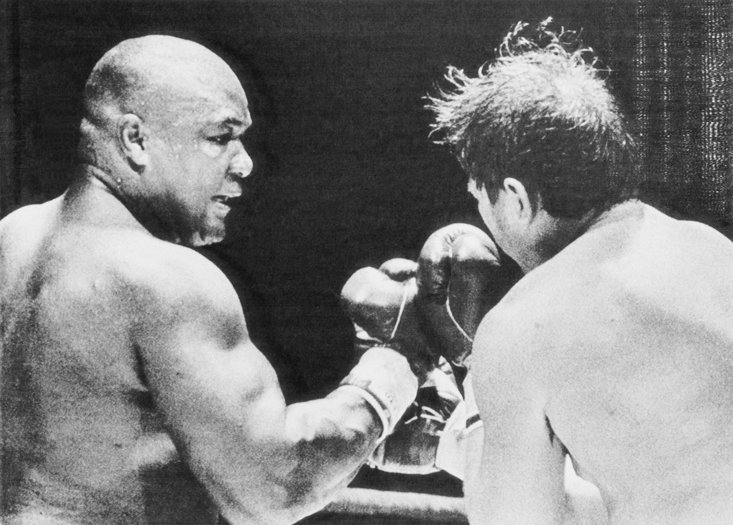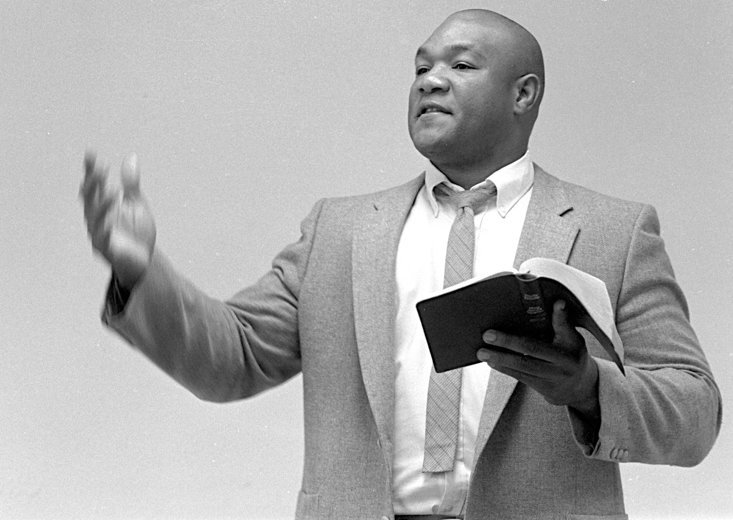George Foreman swept through the heavyweight division like a hurricane, obliterating nearly all who stood in his path without mercy or reason, and then, just like that, he was gone.
For the first part of his professional boxing career, beginning in the summer of ‘69, Foreman was a one-man wrecking crew with dynamite-fused fists, who, until his loss to Muhammad Ali in the Rumble in the Jungle, had assembled a 40-fight winning streak where only three lucky souls survived long enough to hear the final bell.
The chapter came to an undignified end in 1977, three years after his aura of invincibility had been shattered in front of the world by Ali, with a unanimous decision defeat to the talented Jimmy Young in Puerto Rico - a fight that, thanks to exhaustion and heat-stroke, left him on the verge of death in the dressing room and resulted in what he believes was a face-to-face experience with God that changed his life forever. He quit boxing, dedicated his life to the Lord by becoming an ordained minister and vanished into the boxing abyss to become a mere fragment of its long and storied history.
A decade later something awoke the now 38-year-old beast from its slumber. In 1987, Foreman announced he was returning to mount an assault on the heavyweight division. The audacity of the comeback was derided by almost everyone - not only had the former great been in hibernation for the last 10 years, he’d ballooned to well over 300lbs. Having grown up in poverty in Houston’s tough Fifth Ward, where there was no such thing as three meals a day, and without the rigours of daily training to contend with, this was an understandable indulgence.
If people weren’t snidely making remarks on Foreman’s weight gain or his age, they were concerned for his well-being, so why, in the face of so much criticism, mockery and concern, would Foreman lace up his gloves once again and return to a sport that takes no prisoners and quite literally pulls no punches?

The reason, like so many boxing comebacks, was financial. This was long before Foreman’s Lean, Mean Grilling Machine empire had made him one of the richest living boxers in the world and in his exile he had founded the George Foreman Youth and Community Center, a sanctuary that kids of all denominations could visit for guidance and a place in which he had become a father-figure to so many misguided youths, much like himself when he was younger. It’s still open today, but back then it was struggling to keep the lights on and so, on 9 March 1987, he returned to the ring for the first time since that dismal night in Puerto Rico, fighting Steve Zouski, a 32-year-old journeyman with a solid 25-11 record who had tangled with the likes of Mike Tyson, Marvis Frazier and Tony Tubbs.
If people were fearful for Foreman when he announced his comeback, they were severely concerned after his fight with Zouski, which he duly won and earned $24,000 from. Foreman, despite ending proceedings in the fourth round, looked slow, cumbersome and a shadow of his former self. The 5,000 or so onlookers, who had treated the fight as a curiosity more than anything, were far from impressed.
“Hey, I’ve been off for 10 years. Not one year, not 10 months, but 10 years. In those 10 years I got relaxed, I got fat and had babies. What else can you expect?” he joked afterwards.
When he announced that he had the latest heavyweight sensation, Tyson, in his crosshairs, everybody laughed. But, since his spiritual reawakening in that dressing room back in ‘77 Foreman had had faith in abundance, and slowly, with each passing fight, every win and subsequent knockout, people began to believe. He never did get that fight with Tyson but he was a bona fide celebrity amongst the people once again.
The clean-shaven reincarnation of Foreman may have been of a more forgiving nature than his predecessor but try telling that to his victims, with all but one in a 24-fight winning streak succumbing to ‘Big’ George’s brutish power. Soon came the title shots, but taking back what he’d lost to Ali in Zaire nearly 20 years earlier would not come easy. His first and second attempts at world honours were spirited defeats to Evander Holyfield and Tommy Morrison respectively, but the moment that would immortalise Foreman forever was soon to come.

On 5 November 1994, Foreman, now 45, fought the WBA world champion Michael Moorer, 19 years his junior, at the MGM Grand in Vegas. Foreman fever had gone through the roof but, even after two brave title challenges since his return, few believed that he could upset the 3/1 betting favourite who had snatched the title from Holyfield.
Before the fight Foreman said he wanted to lay the ghosts of the Rumble in the Jungle to rest, even going as far as to wear the same red shorts and appointing Ali’s trainer that night, the legendary Angelo Dundee, to serve him in his corner. From the opening bell though, it seemed as if he would throw away his chance to regain the title once again. Moorer controlled the pace, delivering an immense amount of punishment to Foreman, who seemed unfazed by the onslaught, and won virtually every round.
He needed a miracle to win, but faith had served him well so far and he wasn’t going to give up. In his corner, Dundee, who had delivered countless pieces of fight-changing lines of wisdom mid-fight over the years, not least to his charge’s former rival Ali, recognised the dire situation and told Foreman ahead of the seventh round that he had no choice but to stop his foe.
An early body shot from Foreman to Moorer’s much leaner gut slowed the champion down, allowing the veteran challenger to land more consistently than he had in the previous six rounds. As the round progressed Foreman continued to get the upper hand before a big right caught the younger man flush on the jaw, smashing his mouthguard into pieces and splitting his lip in the process. Moorer toppled onto his back and could only get to his knees by the time the referee, Joe Cortez, reached the count of 10. At 45, George Edward Foreman was the oldest world boxing champion ever.

It is arguably the greatest sporting comeback of all-time and one that, in 1987, had been deemed a doomed and foolish endeavour. Had Foreman retired for good in 1977, he would no doubt have been one of the most respected boxers of the 20th century but he would not be the Goliath-like figure he is in boxing today - he is simply one of the most beloved sportsmen in history.
His path was not an easy road to travel and required much more than just his physical strength alone. It took a mental fortitude like nothing sport had seen before, and there are fewer testaments to what faith can achieve in a person than George Foreman.
*18+ | BeGambleAware | Odds Subject To Change